
Last spring I was back in hometown Windsor doing what one does in Windsor: drive around. I often will visit old routes and haunts, see what’s changed and what hasn’t, but this time I was tweeting-about-town, uploading pictures and making comments. I took the above picture at one end of the Chrysler Minivan plant and remarked that it was over a kilometer long. I was suddenly struck by it’s sheer size though I had driven by this place for years and didn’t think much of it: it was simply the normal scale of things in Windsor.
At shift change the empty street above would look like Union Station at rush hour with workers trying to cross over to the parking lots. Human critical mass. Once my 1985 Pontaic Sunbird had a flat along here and as I struggled to change the tire the gates opened and the flood of people surrounded me. No offers of help, just askance looks at my GM vehicle. Later when I drove an old beat up 1986 Honda Accord I knew if I broke down along here it would be best to abandon it as I had chosen the wrong car to drive. A common Windsor bumper sticker says “Out of work? Keep driving foreign.” In Windsor, the make of your car says a lot about your allegiances, or at least where you or one of your parents might work.
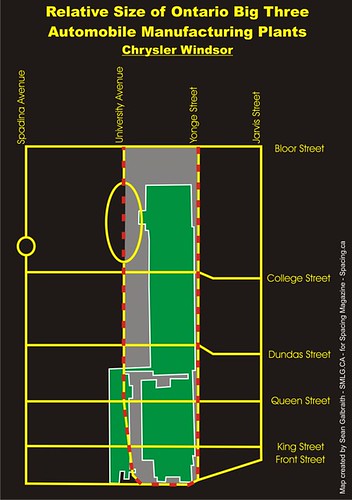
At some point I tweeted that if this plant landed on Toronto it would cover the financial district. I underestimated. Spacing friend Sean Galbraith saw that tweet and made up a series of maps that superimposed the footprint of some of Ontario’s bigger auto plants on Toronto. In Windsor I had nothing to relate the size of the Minivan plant to — and I always drove by it, further obscuring its vast size — so I was shocked that if located in Toronto it would fill nearly the entire space between Yonge and University, from Front to almost Bloor. As the auto industry winds down and plants close, the amount of space these buildings take up will seem even bigger. Here are a few more plants:
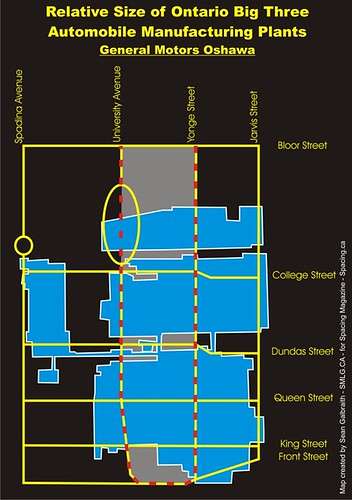

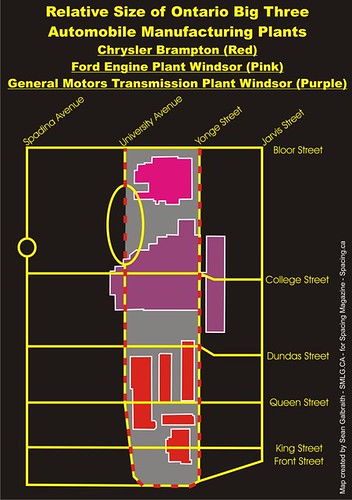
This final map shows a number of plants including the Ford Engine and GM Transmission. What follows are some pictures I took on various walk-drives around the two plants in the past year. What to do with all this space? First the Ford Engine plant:
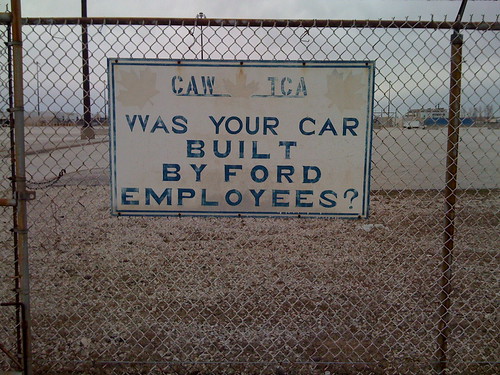
My uncle worked here, 12 hours a day, 7 days a week, for a couple decades.
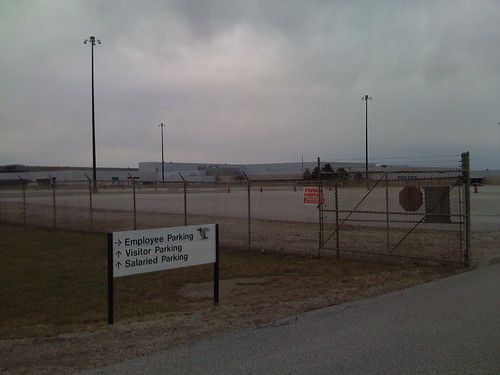

The Ford plant may not have the biggest footprint, but it was surrounded by acres of parking lot. What follows is the GM Transmission plant. It will close in the next year:
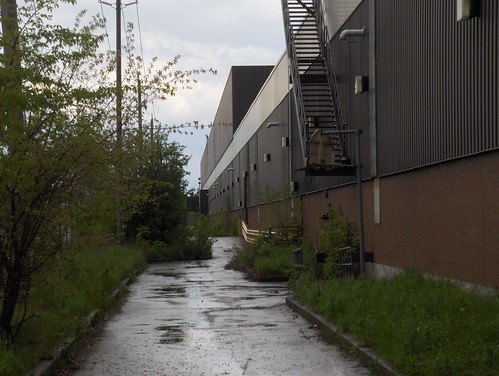

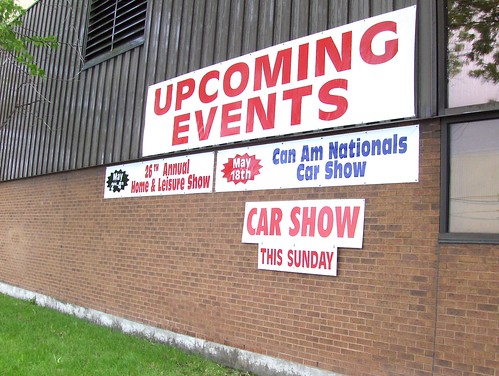
Finding some reuse as exhibition space. The plant strattled both sides of Walker Road (itself named after the Hiram Walkers Distillery, another large employer — I worked there in the bottling room in 1993 (think Lavern and Shirley opening credits) — that is slowly winding down.
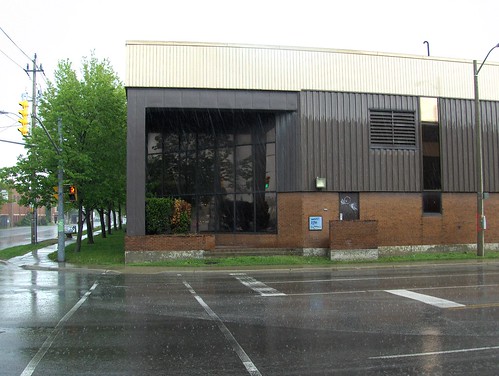

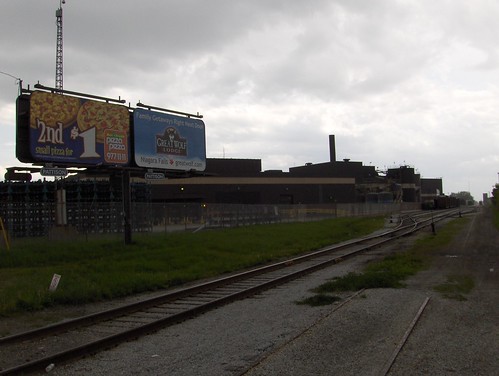
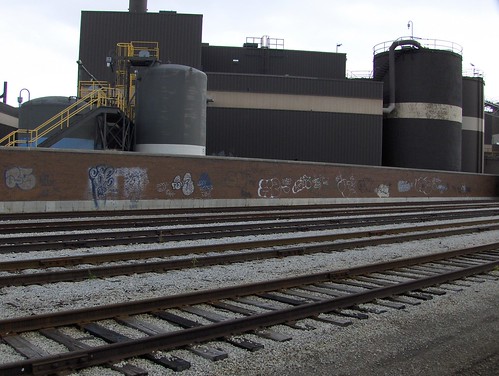
GM Trim Plant
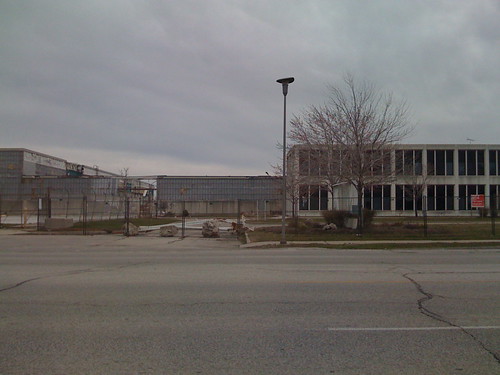
These photos are of the GM Trim Plant, or what was left of it in the spring (and not one of the plants Sean mapped). I caught it just as it was being torn down. Built in the mid-1960s, it produced the seats and interiors for GM vehicles. My mom worked here from 1984 until just a few years ago. For a long time she sewed seats for Cadillac Sevilles but in the last decade of the plant much of that work went to Mexico and GM sold off the plant and “light assembly” contracts were found until they too disappeared. There was nothing light about the toll even this kind of work took on the bodies of my mom and her friends — so many conversations about elbows and hands and carpel tunnel. Factories workers were and often are the walking wounded.
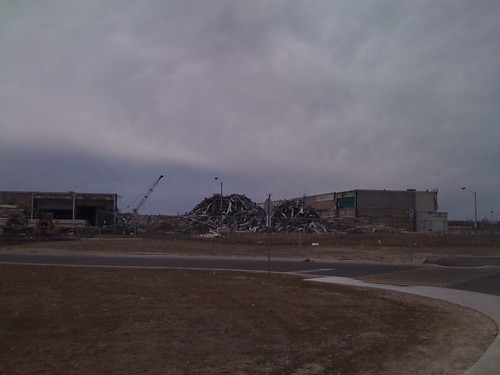
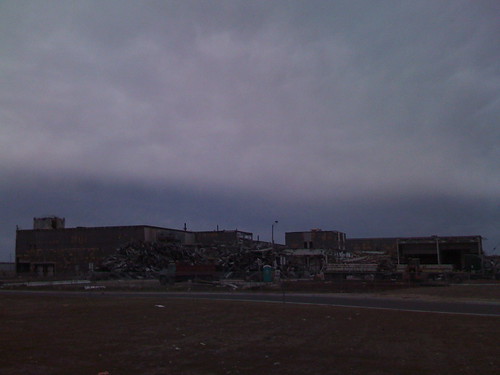
The future?
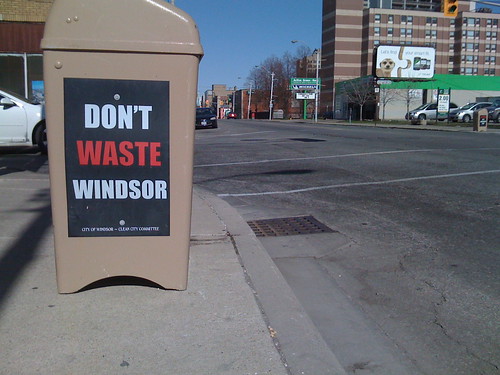
So much of Windsor’s psychological and physical space was given over to the auto plants and it’s unclear what will happen to the city when it disappears. The above photos show the physical space the plants hold while below are just some of the psychological and psychogeographic spaces carmaking takes up in my hometown. A full accounting of how connected the city is to this industry would take up an encyclopedia.
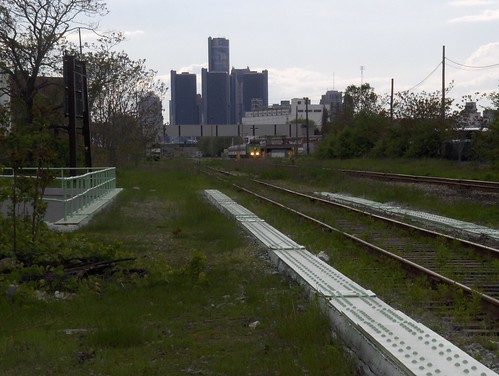
Detroit is always there, in the background.
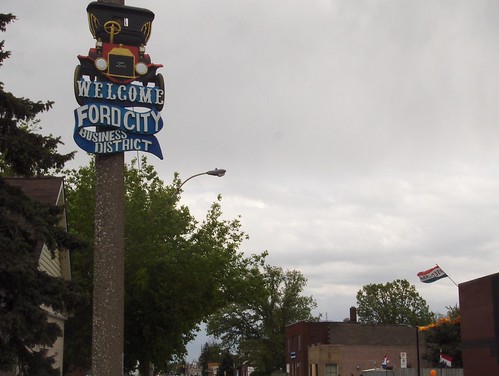
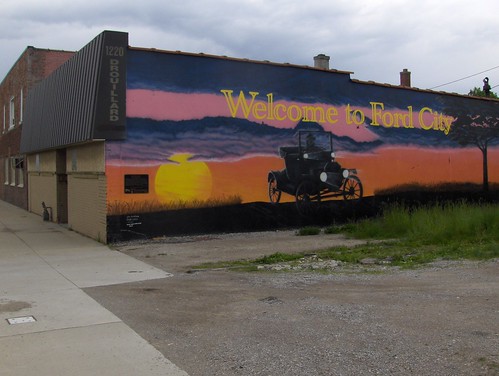





25 comments
Awesome post. I’ve driven by the Windsor plants plenty of times and the size always left me with a sense of awe. Transplanting them into downtown just recreates that sense for me.
As Shawn pointed out, these maps don’t include the size of the parking lots that surround them. Including those, I imagine, would triple the size of their footprints.
Great piece.
I drive by the Oshawa plant all the time and it never struck me until now how mammoth the place actually is.
It underscores one reason why manufacturing and wharehousing has left the city of Toronto for 905.
Joe solway
With plants this size closing, it’s easy for McGuinty to announce closing coal units at Nanticoke and Atikokan today.
This is an amazing juxtaposition of the classic suburban industrial landscape compared to the dense, compact urban landscape of Toronto. Bravo!
Great Post Sean.
Question:
After all the closings are finished:
What major factories will still be operating in Windsor and which will be gone?
(based on current announced plans)
***
Second, I was looking at the google map for Windsor, there was a vast industrial zone along the river, in the south-west that didn’t show any plant names, just the Windsor Pollution Control plant, but there’s no way that’s what is occupying all that space. Just curious.
(Ford, Ford-Essex, Chrysler and GM Transm. all show up on Google)
****
So far my only thoughts are not ones which would make Windsor economically thrive again, but which take advantage of newly vacant lands (maybe). I’m particularly looking at the lands near Ojibway Prarie and Black Oak Park where there are many endangered species, and a very small nature area. Its long been a hope of environmentalists to stitch these parks together and to the water.
But that won’t do much for jobs.
I think Windsor probably needs outside restructuring help. That’s a lot of job loss and a lot of vacant land.
There are some rumours of HoneyWell producing small scale wind turbines in Windsor. Alas, as for most most jobs in manufacturing, will continue to allow mercantilist trading partners free access to our markets while not reciprocating. Eventually production of theses will move to China.
Any hope for new green industries to grow in NA is a pipe dream.
For a good read on the decline of the North American auto industry read……….
The Untold Story of Detroit’s Collapse
http://www.tradereform.org/content/view/1921/1/
China dumping solar panels
http://www.tradereform.org/content/view/1963/1/
President Obama wants to make the United States “the world’s leading exporter of renewable energy,” but in his seven months in office, it is China that has stepped on the gas in an effort to become the dominant player in green energy – especially in solar power, and even in the United States.
Chinese companies have already played a leading role in pushing down the price of solar panels by almost half over the last year. Shi Zhengrong, the chief executive and founder of China’s biggest solar panel manufacturer, Suntech Power Holdings, said in an interview here that Suntech, to build market share, is selling solar panels on the American market for less than the cost of the materials, assembly and shipping.
Small world. I worked as a Supervisor at the trim plant in Cadillac Sew for about three years. Great memories of a lot of really good people I worked with.
Fantastic post.
I made a wrong turn in Oshawa about a year ago, trying to go from the 401 to the GO Station and not realizing that the interchange had been rebuilt in a strange and illogical manner. Suffice to say, I ended up driving alongside one of the disused GM plants, and I couldn’t help but be struck by how massive and empty a space it was. It really becomes mind-boggling once you start to think about it like this.
“A common Windsor bumper sticker says “Out of work? Keep driving foreign.†”
Ha! And look where that got us.
It’s the so-called ‘non-foreign’ carmakers that are less reliable employers within Canada nowadays. You’re likely way better off working for Toyota.
(And really, a company with ownership in a country across the river is just as foreign as a company with ownership across the Pacific. Neither is Canadian by any means ….)
Brilliant post.
I would imagine the carbon footprint of Windsor has dropped precipitously – far less water, electricity and gas consumption. I wonder how this impacts the local utilities as well as the taxes supporting infrastructure maintenance.
James> I don’t know exactly what is closing and not (some are just downsizing, not altogether closing up — though it all seems inevitable, something that was once unthinkable is now somewhere in the near-distant future). Though the Chyrsler full size van plant, that I remember them building as a kid, has been completely torn down now. A dramatic rise and fall in about 20 years.
For more Windsor stuff, go to:
http://www.internationalmetropolis.com
Do a search, Andrew has likely made posts on many of these plants.
As for the South and West section of Windsor, by the pollution plant there is the famous Windsor Salt mines along the Detroit River. Empty land where an Ontario Hydro plant was imploded about 10 years ago, some smaller factories, and the Ford Aluminum plant (I believe). Also a steam-power generating plant. Hmm memory is fuzzy, 9 years after moving away. However notice the streets around Broadway, by the Black Oak Park (fine mountain biking in there — and by the river the plant nearby smells like Kraft Dinner) — they were expropriated by the City for industrial land (the “Brighton Beach” hood) that was never built on. Ghost streets still exist.
Also those Black Oak trails lead to a place on the Detroit River that looks directly into the Zug Island refinery tangle. You ain’t seen nothing till you’ve looked at Zug Island. Look at it via google, gives a sense of the place:
http://bit.ly/3o1jNI
Fascinating stuff! I grew up around Oshawa, and I’ve always wondered how the scale of a city like that compares to Toronto. It’s hard to tell because I experience one on a car or bus, and the other on foot.
Great maps! Most people don’t have an opportunity to visit large industrial structures and it’s always humbling to see just how large they actually are.
I recently went to Nanticoke, on the north shore of Lake Erie, and the turbine hall by itself must be close to a kilometre long.
Can you do a mash up of downtown and Hamilton’s steel mills?
And it’s not only industrial structures. I think a lot of people would be shocked (and perhaps a little depressed) to compare the scale of typical suburban development and infrastructure with downtown development and infrastructure.
For fun, open up these Google maps in separate tabs and toggle back and forth. Compare downtown Toronto:
Yonge and Dundas
with any number of suburban infrastructure at the same scale — here are a few:
Square One in Mississauga
The Hwy. 400/Hwy. 407 interchange in Vaughan
…and the power centres northwest of that interchange
And what about the amount of land the railways used to use near the CN Tower and where CityPlace is being built now? The scale was also quite great.
Considering some of these plants are the length of five or six Toronto subway stops, I’m left wondering how one would get from one end of the plant to the other? Was there any quicker way than a very long walk?
The ultimate irony is that bikes are often used inside.
Most people work in a specific area, either along the line, the paint shop, etc. So they’re not wandering the plant. Those that do have carts and etc.
Michigan is repurposing giant auto plants as film studios according to a recent NYT article:
http://www.nytimes.com/2009/09/09/realestate/09film.html?_r=1
Today’s NYT article “In Michigan, Dream Factories Aim to Replace Auto Sites” reminded me of your post.
http://www.nytimes.com/2009/09/09/realestate/09film.html?ref=todayspaper
I question the representative scale of the factory over-lays on the Toronto map. I grew up in Toronto and walked Front to Bloor on many occaisions.I currently live in Windsor and I have a hard time correlating the spaces. Maybe I’m just desensitized to the enormity of the auto plants.
Line of Sight:
The methodology for creating the maps was very simple. Basically, I used Google Maps and took screen captures of all the plants at the same zoom level, and did the same with the downtown core. I then traced the outline of the plants and overlaid them accordingly. It is possible that I got the wrong zoom for one, though I don’t think I did.
As for the graphic that depicts the Windor plants, keep in mind that those are 3 different plants (one in Brampton) and are not oriented to each other as they exist in real life. While still generally large buildings, they are quite notably smaller than the GTA area plants. I attribute this to their proximity to the huge Detroit area plants, where the assembly takes place.
I can’t comment on your desensitization. 🙂
Jason: Most workers won’t ever have a need to traverse the plant length. For those who do, as was said, bikes are often used (and electric golf carts and the like).
John: I’ll see what I can do re: steel mills. Steel mills won’t have the width of a car plant, but some of them will definitely compete in length.
This is a great article, but it doesn’t even include all the Windsor plants. I spent 5 years in the old Ford foundry which is in the Ford complex (3 plants and a test track) in central Windsor. It would be interesting to see this complex laid out over Toronto. Even more interesting is the understated size of these plants when you include the parking and outlying property. Throw those in and you’d really have a shocking comparison.